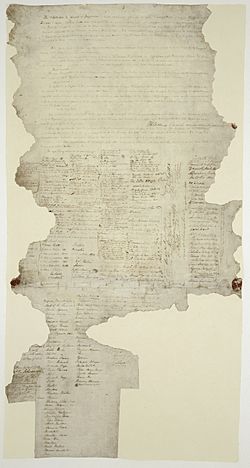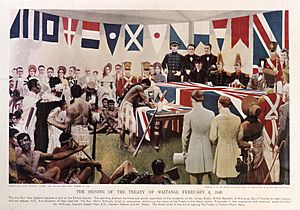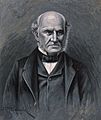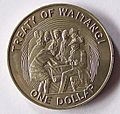Treaty of Waitangi facts for kids

The Waitangi Sheet of the Treaty of Waitangi
|
|
| Context | Treaty to establish a British Governor of New Zealand, consider Māori ownership of their lands and other properties, and give Māori the rights of British subjects. |
|---|---|
| Drafted | 4–5 February 1840 by William Hobson with the help of his secretary, James Freeman, and British Resident James Busby |
| Signed | 6 February 1840 |
| Location | Waitangi in the Bay of Islands, and various other locations in New Zealand. Currently held at National Library of New Zealand, Wellington. |
| Signatories | Representatives of the British Crown, various Māori chiefs from the northern North Island, and later a further 500 signatories |
| Languages | English, Māori |
The Treaty of Waitangi (Māori: Te Tiriti o Waitangi) is a treaty first signed on 6 February 1840 by representatives of the British Crown and Māori chiefs (rangatira) from the North Island of New Zealand. It has become a document of central importance to the history, to the political constitution of the state, and to the national mythos of New Zealand, and has played a major role in framing the political relations between New Zealand's government and the Māori population, especially from the late-20th century.
The treaty was written at a time when the New Zealand Company, acting on behalf of large numbers of settlers and would-be settlers, were establishing a colony in New Zealand, and when some Māori leaders had petitioned the British for protection against French incursions.
It was drafted with the intention of establishing a British Governor of New Zealand, recognising Māori ownership of their lands, forests and other possessions, and giving Māori the rights of British subjects. It was intended by the British Crown to ensure that when Lieutenant Governor William Hobson subsequently made the declaration of British sovereignty over New Zealand in May 1840, the Māori people would not feel that their rights had been ignored. Once it had been written and translated, it was first signed by Northern Māori leaders at Waitangi. Copies were subsequently taken around New Zealand and over the following months many other chiefs signed.
Around 530 to 540 Māori, at least 13 of them women, signed the Māori language version of the Treaty of Waitangi, despite some Māori leaders cautioning against it. An immediate result of the treaty was that Queen Victoria's government gained the sole right to purchase land. In total there are nine signed copies of the Treaty of Waitangi, including the sheet signed on 6 February 1840 at Waitangi.
The text of the treaty includes a preamble and three articles. It is bilingual, with the Māori text inaccurately translated from the English.
- Article one of the Māori text grants governance rights to the Crown while the English text cedes "all rights and powers of sovereignty" to the Crown.
- Article two of the Māori text establishes that Māori will retain full chieftainship over their lands, villages and all their treasures while the English text establishes the continued ownership of the Māori over their lands and establishes the exclusive right of pre-emption of the Crown.
- Article three gives Māori people full rights and protections as British subjects.
The Māori text and the English text differ in meaning significantly, particularly in relation to the meaning of having and ceding sovereignty. These discrepancies led to disagreements in the decades following the signing, eventually contributing to the New Zealand Wars of 1845 to 1872.
During the second half of the 19th century Māori generally lost control of much of the land they had owned, sometimes through legitimate sale, but often due to unfair land-deals, settlers occupying land that had not been sold, or through outright confiscations in the aftermath of the New Zealand Wars.
In the period following the New Zealand Wars, the New Zealand government mostly ignored the treaty, and a court-case judgement in 1877 declared it to be "a simple nullity". Beginning in the 1950s, Māori increasingly sought to use the treaty as a platform for claiming additional rights to sovereignty and to reclaim lost land, and governments in the 1960s and 1970s responded to these arguments, giving the treaty an increasingly central role in the interpretation of land rights and relations between Māori people and the state.
In 1975 the New Zealand Parliament passed the Treaty of Waitangi Act, establishing the Waitangi Tribunal as a permanent commission of inquiry tasked with interpreting the treaty, researching breaches of the treaty by the Crown or its agents, and suggesting ways to fix these. In most cases, recommendations of the Tribunal are not binding on the Crown, but settlements totalling almost $1 billion have been awarded to various Māori groups.
Various legislation passed in the latter part of the 20th century has made reference to the treaty, which has led to ad hoc incorporation of the treaty in law. Nonetheless, the treaty has become widely regarded as the founding document of New Zealand.
The New Zealand government established Waitangi Day as a national holiday in 1974; each year the holiday commemorates the date of the signing of the treaty.
Related pages
Images for kids
-
Captain William Hobson
-
Reverse of a 1990 one dollar coin commemorating the sesquicentenary of the Treaty of Waitangi. Using a different design a much rarer New Zealand crown commemorative coin was also minted in 1935.
See also
 In Spanish: Tratado de Waitangi para niños
In Spanish: Tratado de Waitangi para niños











